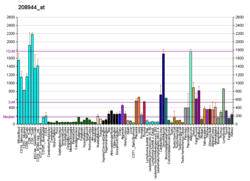TGFBR2
Beta receptor II transformirajućeg faktora rasta (70/80kDa) je beta receptor TGF. TGFBR2 je ljudski gen.
To je gen supresije tumora.[5]
Aminokiselinska sekvenca
urediDužina polipeptidnog lanca je 567 aminokiselina, a molekulska težina 645.68 Da.[6]
| 10 | 20 | 30 | 40 | 50 | ||||
|---|---|---|---|---|---|---|---|---|
| MGRGLLRGLW | PLHIVLWTRI | ASTIPPHVQK | SVNNDMIVTD | NNGAVKFPQL | ||||
| CKFCDVRFST | CDNQKSCMSN | CSITSICEKP | QEVCVAVWRK | NDENITLETV | ||||
| CHDPKLPYHD | FILEDAASPK | CIMKEKKKPG | ETFFMCSCSS | DECNDNIIFS | ||||
| EEYNTSNPDL | LLVIFQVTGI | SLLPPLGVAI | SVIIIFYCYR | VNRQQKLSST | ||||
| WETGKTRKLM | EFSEHCAIIL | EDDRSDISST | CANNINHNTE | LLPIELDTLV | ||||
| GKGRFAEVYK | AKLKQNTSEQ | FETVAVKIFP | YEEYASWKTE | KDIFSDINLK | ||||
| HENILQFLTA | EERKTELGKQ | YWLITAFHAK | GNLQEYLTRH | VISWEDLRKL | ||||
| GSSLARGIAH | LHSDHTPCGR | PKMPIVHRDL | KSSNILVKND | LTCCLCDFGL | ||||
| SLRLDPTLSV | DDLANSGQVG | TARYMAPEVL | ESRMNLENVE | SFKQTDVYSM | ||||
| ALVLWEMTSR | CNAVGEVKDY | EPPFGSKVRE | HPCVESMKDN | VLRDRGRPEI | ||||
| PSFWLNHQGI | QMVCETLTEC | WDHDPEARLT | AQCVAERFSE | LEHLDRLSGR | ||||
| SCSEEKIPED | GSLNTTK |
- Simboli
Arhitektura domena
uredi| Transformirajući faktor rasta beta receptor 2 ektodomena | |
|---|---|
| Kristalna struktura ljudskog domena vezanja liganda za receptor tgf-beta tipa ii | |
| Identifikatori | |
| Simbol | ecTbetaR2 |
TGF beta receptor 2 sastoji se od C-terminal a domena protein-kinaze i N-terminalnog ektodomena. Ektodomen se sastoji od kompaktnog nabora koji sadrži devet beta-lanaca i jedan alfa-heliks stabiliziran mrežom od šest unutrašnjih lanaca disulfidne veze. Topologija presavijanja uključuje središnji petolančani antiparalelni beta-list, u središtu dugačak osam ostataka, prekriven drugim slojem koji se sastoji od dva segmenta lančanih antiparalelnih beta-listova (beta1-beta4, beta3-beta9).[7]
Funkcija
urediOvaj gen kodira člana porodice serin / treonin protein kinaza i potporodice TGFB receptora. Kodirani protein je transmembranski protein koji ima domen protein-kinaze, tvori heterodimerni kompleks sa drugim receptorskim proteinom i veže TGF-beta. Ovaj kompleks receptora/liganda fosforilira proteine, koji zatim ulaze u jedro i regulišu transkripciju podskupine gena povezanih sa ffjska proliferacija|proliferacijom ćelija]]. Mutacije u ovom genu povezane su s Marfanovim sindromom, Loeys-Deitzovim sindromom aneurizme aorte, Osler-Weber-Renduovim sindromom i razvojem različitih vrsta tumora. Karakterizirane su alternativno spojene varijante transkripta koje kodiraju različite izoforme.[8]
Interakcije
urediPokazano je da TGF beta receptor 2 interakcije sa:
Reference
uredi- ^ a b c GRCh38: Ensembl release 89: ENSG00000163513 - Ensembl, maj 2017
- ^ a b c GRCm38: Ensembl release 89: ENSMUSG00000032440 - Ensembl, maj 2017
- ^ "Human PubMed Reference:". National Center for Biotechnology Information, U.S. National Library of Medicine.
- ^ "Mouse PubMed Reference:". National Center for Biotechnology Information, U.S. National Library of Medicine.
- ^ "TGFBR2 - transforming growth factor, beta receptor II (70/80kDa) - Genetics Home Reference". Arhivirano s originala, 10. 8. 2011. Pristupljeno 7. 9. 2008.
- ^ "UniProt, P37173". Pristupljeno 18. 7. 2021.
- ^ a b Hart PJ, Deep S, Taylor AB, Shu Z, Hinck CS, Hinck AP (Mar 2002). "Crystal structure of the human TbetaR2 ectodomain--TGF-beta3 complex". Nature Structural Biology. 9 (3): 203–8. doi:10.1038/nsb766. PMID 11850637. S2CID 13322593.
- ^ "Entrez Gene: TGFBR2 transforming growth factor, beta receptor II (70/80kDa)".
- ^ Yao D, Ehrlich M, Henis YI, Leof EB (Nov 2002). "Transforming growth factor-beta receptors interact with AP2 by direct binding to beta2 subunit". Molecular Biology of the Cell. 13 (11): 4001–12. doi:10.1091/mbc.02-07-0104. PMC 133610. PMID 12429842.
- ^ Liu JH, Wei S, Burnette PK, Gamero AM, Hutton M, Djeu JY (Jan 1999). "Functional association of TGF-beta receptor II with cyclin B". Oncogene. 18 (1): 269–75. doi:10.1038/sj.onc.1202263. PMID 9926943.
- ^ a b Barbara NP, Wrana JL, Letarte M (Jan 1999). "Endoglin is an accessory protein that interacts with the signaling receptor complex of multiple members of the transforming growth factor-beta superfamily". The Journal of Biological Chemistry. 274 (2): 584–94. doi:10.1074/jbc.274.2.584. PMID 9872992.
- ^ Guerrero-Esteo M, Sanchez-Elsner T, Letamendia A, Bernabeu C (Aug 2002). "Extracellular and cytoplasmic domains of endoglin interact with the transforming growth factor-beta receptors I and II". The Journal of Biological Chemistry. 277 (32): 29197–209. doi:10.1074/jbc.M111991200. PMID 12015308.
- ^ Wrighton KH, Lin X, Feng XH (Jul 2008). "Critical regulation of TGFbeta signaling by Hsp90". Proceedings of the National Academy of Sciences of the United States of America. 105 (27): 9244–9. doi:10.1073/pnas.0800163105. PMC 2453700. PMID 18591668.
- ^ Datta PK, Chytil A, Gorska AE, Moses HL (Dec 1998). "Identification of STRAP, a novel WD domain protein in transforming growth factor-beta signaling". The Journal of Biological Chemistry. 273 (52): 34671–4. doi:10.1074/jbc.273.52.34671. PMID 9856985.
- ^ Datta PK, Moses HL (maj 2000). "STRAP and Smad7 synergize in the inhibition of transforming growth factor beta signaling". Molecular and Cellular Biology. 20 (9): 3157–67. doi:10.1128/mcb.20.9.3157-3167.2000. PMC 85610. PMID 10757800.
- ^ Kawabata M, Chytil A, Moses HL (Mar 1995). "Cloning of a novel type II serine/threonine kinase receptor through interaction with the type I transforming growth factor-beta receptor". The Journal of Biological Chemistry. 270 (10): 5625–30. doi:10.1074/jbc.270.10.5625. PMID 7890683.
- ^ Razani B, Zhang XL, Bitzer M, von Gersdorff G, Böttinger EP, Lisanti MP (Mar 2001). "Caveolin-1 regulates transforming growth factor (TGF)-beta/SMAD signaling through an interaction with the TGF-beta type I receptor". The Journal of Biological Chemistry. 276 (9): 6727–38. doi:10.1074/jbc.M008340200. PMID 11102446.
- ^ De Crescenzo G, Pham PL, Durocher Y, O'Connor-McCourt MD (maj 2003). "Transforming growth factor-beta (TGF-beta) binding to the extracellular domain of the type II TGF-beta receptor: receptor capture on a biosensor surface using a new coiled-coil capture system demonstrates that avidity contributes significantly to high affinity binding". Journal of Molecular Biology. 328 (5): 1173–83. doi:10.1016/s0022-2836(03)00360-7. PMID 12729750.
- ^ Rotzer D, Roth M, Lutz M, Lindemann D, Sebald W, Knaus P (Feb 2001). "Type III TGF-beta receptor-independent signalling of TGF-beta2 via TbetaRII-B, an alternatively spliced TGF-beta type II receptor". The EMBO Journal. 20 (3): 480–90. doi:10.1093/emboj/20.3.480. PMC 133482. PMID 11157754.






